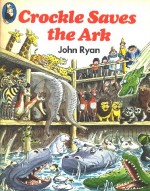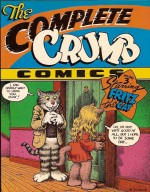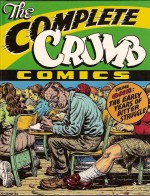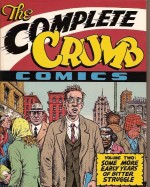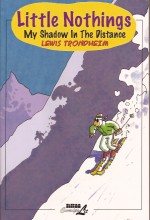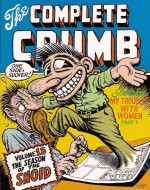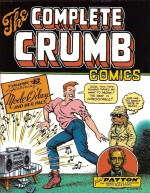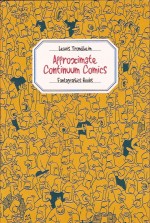

By Reed Waller & Kate Worley with James M. Vance (NBM/Amerotic)
Set ISBN: 978-1-56163-601-3
Vol. 4 ISBN: 978-1-56163-451-4, vol. 5 ISBN: 978-1-56163-451-4, vol. 6 ISBN: 978-1-56163-451-4, vol. 7 ISBN: 978-1-56163-451-4
These books are intended to make adults laugh and think and occasionally feel frisky. If the cover images haven’t clued you in, please be warned that these items contain nudity, images of sexual intimacy – both hetero and homosexual – and language commonly used in the privacy of the bedroom and probably school playgrounds whenever supervising adults aren’t present.
If that sort of thing offends you, read no further and don’t buy these books. The rest of us will just enjoy one of the best graphic novel experiences ever created without you.
Omaha the Cat Dancer began during the 1970s as an “underground†venture and over slow torturous decades grew into a brilliant but controversial drama of human fallibility were all the actors just happened to be ordinary people with animal characteristics. What most people noticed was the matter-of-fact and constant inclusion of graphic sex acts, extremely well rendered.
As there’s only so much a man of my hard-lived years can endure and certainly only so much me you can stand, I’ve divides this graphic novels review of the series and specifically the glorious seven-volume complete set that prompted it in two (see yesterday’s post for the rest). The entire supremely economical shrink-wrapped gift set is available for your reading pleasure and you’d be bonkers not to not take advantage of the fact, but if you are of a cautious nature most individual editions can still be obtained through internet retailers.
The stunning, addictive saga of the erotic dancer, her bone-headed boyfriend and the anthropomorphic extended ensemble cast takes a dark and dreadful turn with Volume 4 (re-presenting the Kitchen Sink Omaha issues #10-13 and the one-page gag strip ‘Alterations’ from Fire Sale #11988-1989) as the mysterious death of Charles Tabey Sr., the increasing violence and oppression of the Campaign for Decency and a seemingly constant stream of personal revelations strain Omaha and Chuck’s relationship to the breaking point.
The Story resumes after an introduction from writer James Vance (who married Kate Worley after she split up with Waller and worked with the artist to finish the saga from her notes after her untimely death in 2004), before the tense drama kicks into high gear as Chuck comes to terms with the shocking knowledge that his mother didn’t die decades ago. The pressure seems to be affecting him badly – or perhaps the thought of all the wealth and responsibility – and the decent young man is becoming as exploitative, abusive and creepy as his manic dad was, but even though he’s acting paranoid, it doesn’t mean he’s hasn’t got real and deadly enemies. The situation isn’t helped by learning that somewhere his beloved Omaha has a husband she hasn’t quite divorced and never ever mentioned…
The sinister Senator Bonner is ratchetting up the pressure of his anti-smut campaign and even close ally Jerry is working to his own agenda, with the assistance of avaricious partner Althea. Confused, lonely and neglected, Omaha devotes her energies to dancing for the upcoming video for Shawn’s band, and Rob confronts Shelley whom he believes ordered the attempt on his life and torching of his studio…
At long last the will is read and Chuck does indeed inherit the bulk of his father’s holdings and, apparently, many of Tabey Sr.’s deranged obsessions. The far more intriguing than she appears Shelley acts on Rob’s misperceived accusations whilst her lover/carer Kurt Huddle finds part-time employment with the mysterious Mr. Lopez – the last major player in an increasingly complex game. Meanwhile high-powered call-girl, blackmailer and keeper of Secrets Joanne re-insinuates herself with Jerry and Chuck and Bonner in a terrifying confrontation threatens to destroy Omaha and Chuck in his own blackmail scheme…
During the video shoot Omaha and Joanne compare notes on Bonner, after which the capable call-girl enlists Rob’s photographic aid in a scheme to get the goods on the hypocritical Senator – with whom she shares a highly secret and extremely specialised professional relationship…
Whilst both Joanne and Rob are practising their unique skills the senator is murdered in the most compromising of all positions and the story moves effortlessly from human drama to dark murder mystery. Abandoned, bewildered, angry and very hurt, Omaha leaves town unaware that both she and Joanne are suspects in the Bonner murder case…
As she heads for a new life in rural Wisconsin, Chuck is learning some long-forgotten personal history from his mother, but no matter how she disguises her appearance that increasingly popular video means the cat dancer will never be truly safe or unseen…
Volume 5 is introduced by Neil Gaiman, after which issues #14-17 (1990-1992) find the lovers painfully adapting to life apart, with all of Omaha’s old friends wondering where she’s gone. Meanwhile in Lawrenceville, Wisconsin, after an abortive stab at office work for an all-too-typical, male-dominated factory, “Susan Johnson†goes back to honest work dancing in the town’s only strip joint, making some reliable new friends and meeting a young man who will become far more…
In Mipple City, Joanne and her lawyer finally clear her of suspicion in Bonner’s murder, Jerry is planning to reopen infamous bordello The Underground as a legitimate nightclub, and Chuck is making new friends and intimate acquaintances whilst spending his days trying to save the Bohemian A Block district from redevelopment, inadvertently getting far closer to the heart of all the various intrigues that threaten the players in the drama, and Jerry’s business partner Althea reveals her true colours and allies. At Senator Bonner’s funeral Lopez reveals an unsuspected connection to the venomous politician…
Shelley has made new friends too (in a scathing and utterly delightful episode exposing unexpected biases in certain sorts of feminists and do-gooders), Joanne is increasingly at odds with Rob regarding the films of Bonner’s last moments and when Jerry invites Chuck to become a partner in his new nightclub Althea tries to secure the deal by offering herself as sweetener… or does she actually have another reason for her bold advances?
Kurt and Shelley’s relationship begins to show signs of strain but in Lawrenceville “Susan†is relaxed and happy, with the strength to contact the friends she ran out on.
In Mipple, the cops are slowly uncovering some uncomfortable facts about everybody in the Bonner case when the Senator’s private secretary comes forward with new information, whilst Joanne is finally securing her final weapon necessary to expedite her plans…
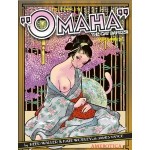
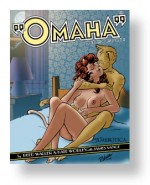
The final Kitchen Sink issues (#18-20, 1993-1994) comprise the major part of the sixth volume, and follow an introduction from Terry Moore, a brief discourse on the cat dancer cast’s other appearances and a few shorts pieces from diverse places.
First there’s a delightful humorous foray into mainstream comics from Munden’s Bar Annual #2 in 1991. ‘A Strip in Time’, wherein the exotic kitty pops up in the legendary pan-dimensional hostelry, after which two short and sexy vignettes originally produced for The Erotic Art of Reed Waller , one untitled and the other graced with the subtly informative designation ‘Waking Up Under a Tent’, act to somewhat offset the angst and drama of the main event.
Rob learns what Shelley’s actual role was in the arson attack on his shop, Joanne takes a live-in position with Mr Lopez and after many abortive attempts Chuck and Omaha finally speak. As Thanksgiving dawns many of Omaha’s friends gather for a momentous dinner, things start to unravel for the bad-guys trying to destroy A Block and in Wisconsin, just as she is becoming reconciled with Chuck, the cat dancer’s fling with appreciative punter Jack intensifies to a crisis point. Meanwhile elsewhere, somebody with an intimate knowledge of her recognises the hot dancer in a rock video and begins making fevered inquiries…
When Shawn’s touring band reaches Lawrenceville and discover “Susie†is Omaha, the scene is set for her return to Mipple City, where, after being arrested in connection with Bonner’s murder, Chuck’s mother reveals the whole story of her past and the sordid truth of Calvin Bonner’s obsessive depravity and Charles Tabey’s bi-polar affliction. In light of the horrific revelations Chuck seems to go completely off the deep end and, far too late, his friends and family realise that money and looks might not be the only things the son inherited from the father…
Next, just a smidge out of chronological order, comes ‘Tales of Mipple City: Rob Steps Out’ a charming first date tale which first appeared in the anthology series Gay Comics #22 (1994) after which the tension and revelations resume as the cops release Maria Elandos Tabey, whilst her son is sectioned. In Lawrenceville, Susie gets an unforgettable farewell from Jack after which she returns to her true love who has never needed her more…
The final volume in this magnificent series features the last four issues published by Fantagraphics as Omaha the Cat Dancer volume 2, #1-4 (1994-1995). The series has at times seemed cursed: plagued by illness and creative problems which have taken its toll on all the creators. The creators ended their relationship in spectacular fashion at this time and only began working together again in 2002. Soon after Kate Worley died from cancer and it seemed the saga was destined to remain an unfinished masterpiece, but in 2006 Waller and Worley’s husband James Vance began to finish the job from her notes, with the concluding chapters serialised in the magazine Sizzle. When those final instalments are finally collected the completed Omaha the Cat Dancer will be possibly the finest adult comics tale in history…
For now however the brilliant yarn reaches a kind of conclusion here as after an introduction from honorary Mipple City resident Denis Kitchen, and a stunning cartoon recap Omaha and Chuck renew their relationship, Jerry and Shelley and Rob and Joanne reach workable détente agreements and that missing husband tracks the cat dancer to her new home. Set over the Christmas/New Year period, all the various plot threads come together during an unforgettable party at Chuck’s palatial new house, although the hung-over aftermath promises that there are still stories to be told and loose ends to be knotted off once and for all.
Even if the saga stopped here, Omaha the Cat Dancer would be an incredible narrative achievement and groundbreaking landmark of comics creation, but with the promise of a final resolution still to come, it looks set to become an icon of our industry, celebrated forever for moving beyond simple titillation and happy, innocent prurience to become a fully matured work of Art.
Captivating, intense, deeply moving and addictively engrossing, Omaha never forgets to be also be fun and fabulous and utterly inclusive: full of astonishingly well drawn, folk (admittedly largely furry or feathered folk) happily naked and joyously guilt – free… at least about sex…
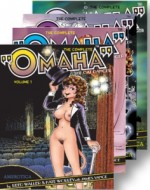
No cats, dogs, birds or ferrets were harmed, abused, distressed or disagreeably surprised in the making of these lovely, lovely books, so if you’re open-minded, fun-loving and ready for the perfect grown-up adventure please take advantage of this unmissable opportunity. You won’t regret it….
© 1987-1996 Reed Waller & Kate Worley. Contents of these editions © 2005-2008 NBM. All Rights Reserved.

